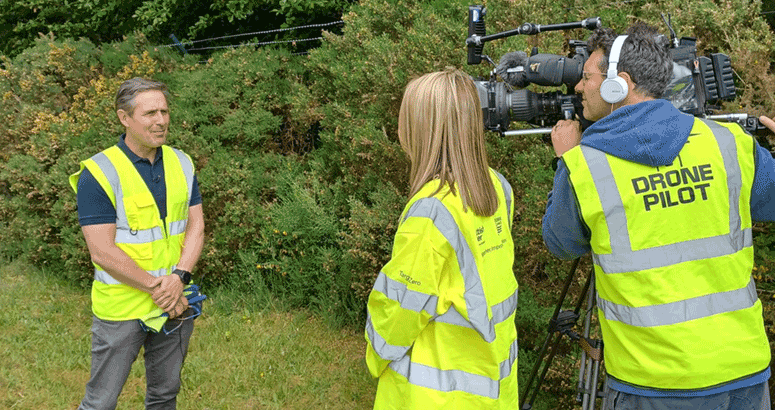BLOG: Scotland’s weather and our water
07 July 2023
Brian McCarthy
Being filmed for a STV inverview
“a reduction of 20% in hot water use would not only save on our individual energy bills, but it could help reduce the country’s total carbon emissions by as much as 1%”
Brian McCarthy
Economic Demand Manager, Scottish Water
I had the pleasure of meeting thousands of Scottish Water customers recently at the Royal highland Show. I was extremely proud of my colleagues and the conversations we had with everyone about their water use over the four-day event.
Most people were surprised or even horrified that as individuals they use around 181 litres per day. This is a big number - many didn’t recognise they used that volume.
But if you consider every toilet flush is 7 litres, an average shower (which is 8 minutes) could be 80 litres and the average washing machine load above 40 litres it doesn’t take long to add up. Ask yourself, do you turn off the tap when brushing your teeth? If not, you could be wasting 5 litres every minute.
It’s my job to know about the water people in Scotland use at home and at work. I can estimate what the average home uses every day, I know what business customers use each year and I know what we take from the environment to provide a great service to everyone connected to the public water network in Scotland.
But why should you have any idea how much you use and why should you care?
Billy Connolly said: “There are two seasons in Scotland - June and winter!”. Making a joke about rainfall in Scotland is commonplace and that message has travelled far and wide. Everyone thinks it rains all the time but is that really the case?
I’m no scientist, but it’s my experience that we are seeing longer, drier and warmer periods through spring and summer months and the rain that does fall can seem more extreme. It’s no stretch to say we are seeing more extreme weather patterns throughout the year - and that matters because it alters the potential availability of water when and where we need it most.
Since the middle of May, with warmer weather and a prolonged dry period, the demand for water increased dramatically across Scotland. To keep up, we were delivering an additional 150 million litres a day. That went up to 250 million litres per day, the equivalent of 125 Olympic swimming pools, over two consecutive days in the middle of June. If you consider the normal flow going to houses throughout the country is nearly 1000 million litres a day this equates to a 15% to 25% increase.
I am confident that most of the additional water is being used in outdoor spaces and since we had a few days with rain the demand dropped significantly. Not many people know a garden hose can use as much as 1000 litres in an hour, but now you do, and you can take steps to reduce the amount you use.
It's also worth noting that before covid restrictions the average volume was around 165 litres per day - clearly the changes to living and working patterns are having a knock-on effect on our use of resources like water and energy.
By comparison people South of the border in England and Wales use on average 145 litres per day so why we are different? Is it because we think we have an abundance of resource that will be there forever?
Scottish Water is licensed to abstract water from 417 individual water sources across the country, not the 30,000 lochs and reservoirs that people think we have access to. We estimate we could only ever capture 1% of all the rain that falls on Scotland, so we don’t even have access to all that rain people think falls constantly.
The water we use in Scotland accounts for roughly 6% of the total carbon emissions in the country. That’s not far off equalling the aviation industry. 1% relates to water treatment, water distribution and waste water management, and 5% relates to heating water in the home. We heat half of the water we use each day so a reduction of 20% in hot water use would not only save on our individual energy bills, but it could help reduce the country’s total carbon emissions by as much as 1% which is a considerable prize.
I am confident that most customers we spoke to at the weekend have a new appreciation for our precious natural resource and know how they can make small changes which could make a big difference. I now hope, after reading this, you will also think more about how you use water every day.
After all, Water is our most precious natural resource, and it is always worth saving.







